VTNE Review: Blood Smear Evaluation
1/43
There's no tags or description
Looks like no tags are added yet.
Name | Mastery | Learn | Test | Matching | Spaced |
|---|
No study sessions yet.
44 Terms
phagocytosis
the release of substances that modulate the immune system and the the production of antibodies
function of WBCs
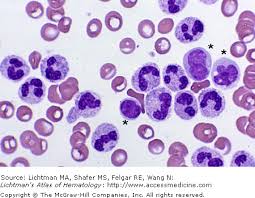
neutrophils
most abundant WBCs
nucleus is irregular and elongated
nucleus in horse neutrophils have heavily clumped, coarse chromatin
bovine neutrophils have darker pink cytoplasm
primary function is phagocytosis
increased number usually indicate infection or inflammation

heterophil
in avians, reptiles, some fish, guinea pigs, rabbits, etc, this cell is functionally equivalent to a neutrophil
have distinct eosinophilic granules in their cytoplasm
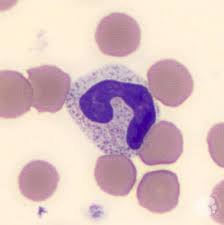
band neutrophil
nucleus is horseshoe shaped
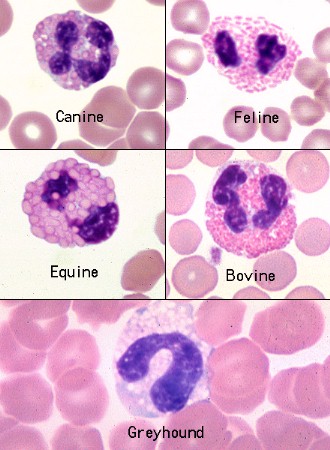
eopsinophil
contain a nucleus that is similar to that of neutrophils, but the chromatin is usually not as coarsely clumped
canine:
granules vary in size, stain less intently than other species, dark red and round
feline:
granules are small and rod shaped and numerous
equine:
granules are large and round to oval, stain an intense orange color
capable of phagocytosis but primary function is to modulate the immune system
increased numbers are commonly seen in patients with allergic reactions and parasite infections
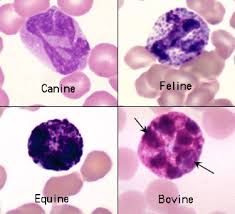
basophils
nuclei are similar to monocytes
granules in dogs are few in number and stain a purple to blue-black color
equine and bovine granules are more numerous and tend to stain a blue-black color and may completely pack the cytoplasm
feline granules are round and stain a light lavender color
involved in the mediation of the immune system
increased numbers are seen with a variety of inflammatory and infectious conditions
not commonly seen on the blood smear
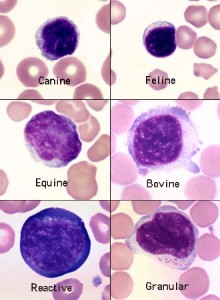
lymphocyte
most abundant WBCs in ruminant patients
slightly indented nuclei
chromatin is coarsely clumped and the cytoplasm is light blue and scanty
chromocenters which are areas of condensed chromatin should not be confused with nuclei
normal bovine lymphocytes may contain nucleolar rings and are large and difficult to distinguish from monocytes or neoplastic lymphoid cells
major function is the production of antibodies
increased number often indicate a viral infection
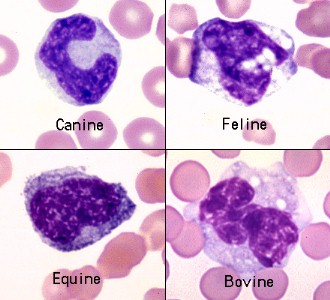
monocytes
largest of the WBCs
nucleus is occasionally the shape of a kidney bean but it is often elongated, lobulated, amoeboid
chromatin is more diffuse and cytoplasm is a blue gray color and it may contain vacuoles and small, pink granules
major function is phagocytosis
increased numbers are seen in a variety of chronic infections
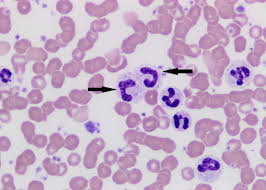
Pelger-Huet anomaly
congenital hereditary defect that is characterized by the hypo-segmentation of all the granulocyte nuclei
believed to result from an autosomal-dominant trait and is most common in Australian shepherd dogs
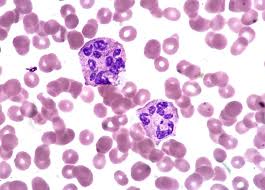
nuclear hypersegmentation
neutrophils with more than five lobes
usually attributed to the aging of neutrophils either in vivo or in vitro
seen in the blood smears of poodles with poodle macrocytosis
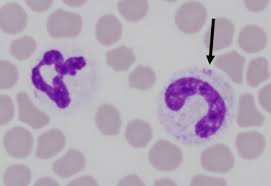
toxic change
most common disease induced cytoplasmic changes in neutrophils
associated with conditions such as inflammation, infection, and drug toxicity
types include cytoplasmic basophilia, Dohle bodies, vacuoles or “foaminess”, and rarely, intensely stained primary granules referred to as toxic granulation
thought to be caused by a decreased length of time of neutrophil maturation within the marrow

atypical lymphocytes
may have basophilic cytoplasm and cleaved nuclei and may show evidence of asynchronous maturation of the nucleus and cytoplasm
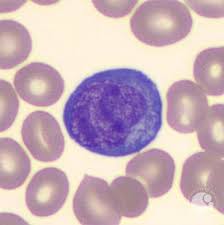
reactive lymphocytes
have increased basophilia and may have more abundant cytoplasm
sometimes have a larger and more convoluted nucleus
changes usually caused by antigenic stimulation secondary to vaccination or infection
also referred to as immunocytes
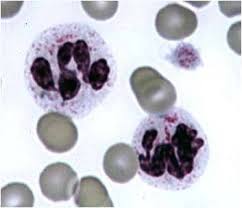
Birman cat neutrophil granulation anomaly
contain fine eosinophilic to magenta granules
inherited as an autosomal-recessive trait
neutrophil function is normal and affected cats are healthy

Chediak-Higashi syndrome
have large fused lysosomes within the cytoplasm and stain lightly pink or eosinophilic
affected animals have a slight tendency to bleed, because their platelet function is abnormal
most often reoprted in persian cats but can also occur in cattle, foxes, and other species

siderotic granules
granules of hemosiderin may be present in the nuetrophils and monocytes of animals with hemolytic anemia
appear similar to Dohle bodies but can be differentiated with the use of Prussian blue stain
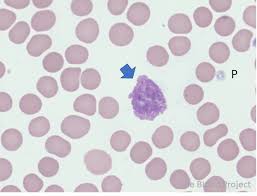
smudge cells
sometimes referred to as basket cells
degenerative leukocytes that have ruptured
large numbers are associated with leukemia
karyolysis
degenerative change to the nucleus that is characterized by the dissolution of the nuclear membrane
usually affects neutrophils and is associated with the presence of septic exudates
karyorrhexis
refers to the fragmentation of the nucleus after cell death
pyknosis
refers to the condensing of the nucleus as the cell dies
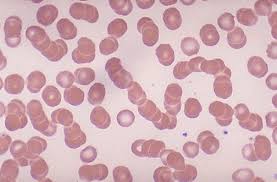
rouleaux
involves the grouping of erythrocytes in stacks
increased formation is seen with increased fibrinogen or globulin concentrations
accompanied by an increase in the erythrocyte sedimentation rate
seen in healthy horses and may also be present from healthy cats and pigs

autoagglutination
occurs in immune mediated disorders in which antibody coats the erythrocyte, resulting in bridging and clumping of RBCs
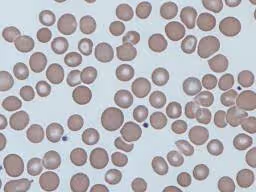
anisocytosis
variation in the size of RBCs
may indicate the presence of microcytes and/or macrocytes
common finding in normal bovine blood
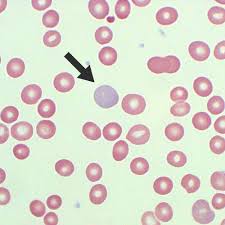
polychromasia
refers to erythrocytes that exhibit a bluish tint when stained with Romanowsky-type stain
blue tint is a result of the presence of organelles that remain within the cytoplasm (young cells)
seen in high numbers during regenerative anemia
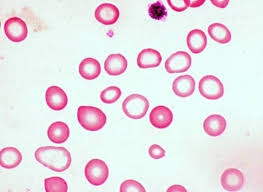
hypochromasia
decreased staining intensity that is caused by an insufficient amount of hemoglobin within the cell
iron deficiency is the most common cause
will always have microcytosis which is determined by a decreased MCV
hyperchromatophilic
refers to cells that appear to be more darkly stained than normal
gives the appearance that the cells are oversaturated with hemoglobin
usually microcytes or spherocytes
poikilocytes
abnormally shaped erythrocytes
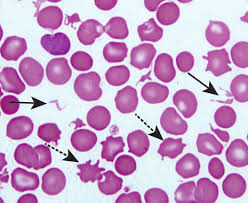
schistocytes
RBC fragments, usually formed as a result of the shearing of the RBC via intravascular trauma
may be observed with DIC when erythrocytes are broken by fibrin strands, with vascular neoplasms and with iron deficiency
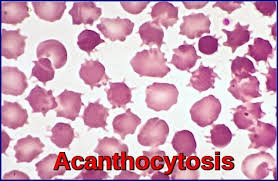
acanthocytes
also called spur cells
irregular, spiculated RBCs with a few unevenly distributed surface projections of variable length and diameter
seen in patients with altered lipid metabolism
presence in middle aged to old large breed dogs with concurrent regenerative anemia is suggestive of hemangiosarcoma
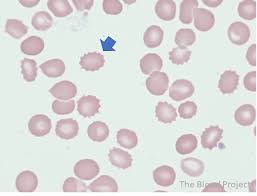
echinocytes
also called burr cells
spiculated cells with numerous short, evenly spaced, blunt to sharp surface projections of uniform size and shape
common term for abnormality is crenation
can be seen in:
renal disease and lymphosarcoma in dogs
after exercise in horses
samples from healthy pigs
after rattlesnake, coral snake, water moccasin, and asp viper envenomation in dogs
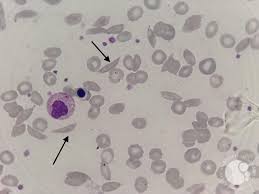
drepanocytes
also called sickle cells
observed in the blood of normal deer and angora goats
thought to be an in vitro phenomenon that is caused by high oxygen tension
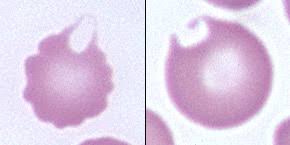
keratocytes
referred to as helmet cells, blister cells, or bite cells
has been associated with hemangiosarcoma, neoplasia, glomerulonephritis, and various hepatic diseases
cell may appear to contain a vacuole
believed to form from intravascular trauma that involves the bisection of the cell by fibrin strands
have also been demonstrated in blood from patients with anemia, liver disorders, and myelodysplastic syndrome
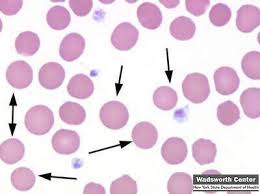
spherocytes
darkly staining RBCs with reduced or no central pallor
not easily detected in species other than dogs
have a reduced amount of membrane surface area as a result of partial phagocytosis
suggest the immune mediated destruction of RBCs, resulting in hemolytic anemia
also may be seen after transfusion with mismatched or improperly stored blood, after snake envenomation, RBC parasites, and zinc toxicity
leptocytes
characterized by an increased membrane surface area relative to cell volume
target cells have a central area of pigment surrounded by a clear area and then a dense ring of peripheral cytoplasm
may also appear as folded cells
barr cells
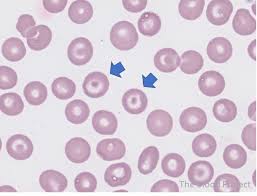
target cell
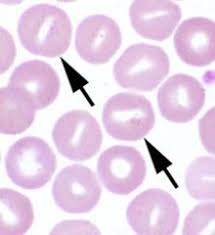
barr cell
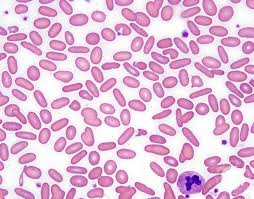
elliptocytes
erythrocytes from camelid species and nonmammals are normally oval or elliptical in shape
in other species, these cells are associated with lymphoblastic leukemia, hepatic lipidosis, portosystemic shunts, and glomerulonephritis

eccentrocytes
described in patients with DKA or neoplasia, with Babesia canis infections, and after the ingestion of oxidants such as garlic, onions, and acetaminophen
appear to have their hemoglobin primarily pushed to one side
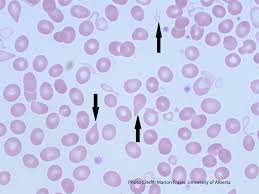
dacryocytes
tear drop shaped cells that are seen with myelofibrosis and certain other myeloproliferative diseases
also identified in blood from llamas and alpacas that are iron deficient

basophilic stippling
presence of small, dark blue bodies within the erythrocyte
observed in Wright stained cells and represents residual RNA
common in immature RBCs of ruminants and occasionally in cats during a response to anemia
also characteristic of lead poisoning
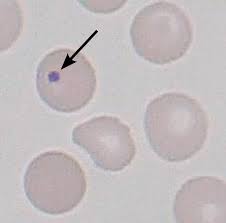
Howell Jolly bodies
basophilic nuclear remnants that are seen in young erythrocytes during the response to anemia
increased numbers may be seen after the removal of the spleen or with splenic disorders
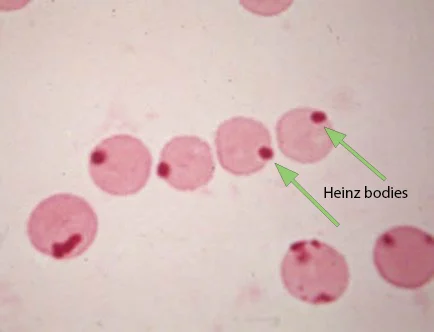
Heinz bodies
round structures that represent denatured hemoglobin and that are caused by certain oxidant drugs or chemicals
denatured hemoglobin becomes attached to the cell membrane and appears as a pale area with Wrights stain
normal cats have Heinz bodies in as many as 5% of their RBCs
often increased in concentration with diseases such as lymphosarcoma, hyperthyroidism, and diabetes mellitus in cats
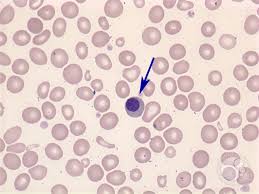
nucleated erythrocytes
represent early release of immature cells during anemia
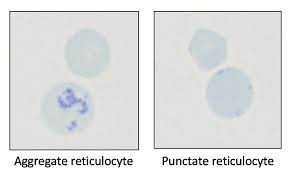
aggregate and punctate (cats) reticulocytes